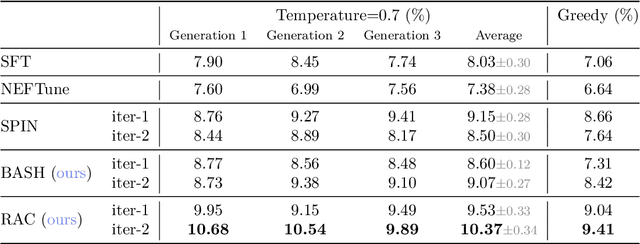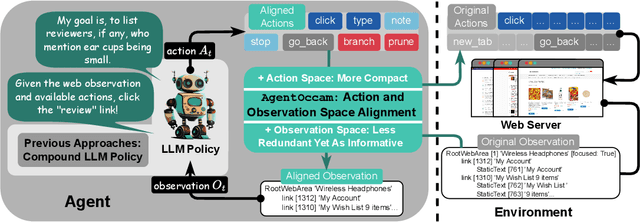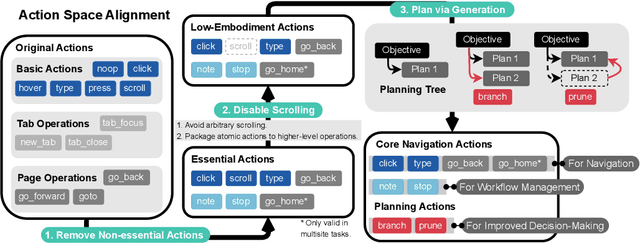Yao Liu
From Demonstrations to Rewards: Alignment Without Explicit Human Preferences
Mar 15, 2025Abstract:One of the challenges of aligning large models with human preferences lies in both the data requirements and the technical complexities of current approaches. Predominant methods, such as RLHF, involve multiple steps, each demanding distinct types of data, including demonstration data and preference data. In RLHF, human preferences are typically modeled through a reward model, which serves as a proxy to guide policy learning during the reinforcement learning stage, ultimately producing a policy aligned with human preferences. However, in this paper, we propose a fresh perspective on learning alignment based on inverse reinforcement learning principles, where the optimal policy is still derived from reward maximization. However, instead of relying on preference data, we directly learn the reward model from demonstration data. This new formulation offers the flexibility to be applied even when only demonstration data is available, a capability that current RLHF methods lack, and it also shows that demonstration data offers more utility than what conventional wisdom suggests. Our extensive evaluation, based on public reward benchmark, HuggingFace Open LLM Leaderboard and MT-Bench, demonstrates that our approach compares favorably to state-of-the-art methods that rely solely on demonstration data.
D3: Diversity, Difficulty, and Dependability-Aware Data Selection for Sample-Efficient LLM Instruction Tuning
Mar 14, 2025Abstract:Recent advancements in instruction tuning for large language models (LLMs) suggest that a small, high-quality dataset can significantly equip LLMs with instruction-following capabilities, outperforming large datasets often burdened by quality and redundancy issues. However, the challenge lies in automatically identifying valuable subsets from large datasets to boost both the effectiveness and efficiency of instruction tuning. In this paper, we first establish data selection criteria based on three distinct aspects of data value: diversity, difficulty, and dependability, and then propose the D3 method comprising two key steps of scoring and selection. Specifically, in the scoring step, we define the diversity function to measure sample distinctiveness and introduce the uncertainty-based prediction difficulty to evaluate sample difficulty by mitigating the interference of context-oriented generation diversity. Additionally, we integrate an external LLM for dependability assessment. In the selection step, we formulate the D3 weighted coreset objective, which jointly optimizes three aspects of data value to solve for the most valuable subset. The two steps of D3 can iterate multiple rounds, incorporating feedback to refine the selection focus adaptively. Experiments on three datasets demonstrate the effectiveness of D3 in endowing LLMs with competitive or even superior instruction-following capabilities using less than 10% of the entire dataset.
Human Cognition Inspired RAG with Knowledge Graph for Complex Problem Solving
Mar 09, 2025Abstract:Large language models (LLMs) have demonstrated transformative potential across various domains, yet they face significant challenges in knowledge integration and complex problem reasoning, often leading to hallucinations and unreliable outputs. Retrieval-Augmented Generation (RAG) has emerged as a promising solution to enhance LLMs accuracy by incorporating external knowledge. However, traditional RAG systems struggle with processing complex relational information and multi-step reasoning, limiting their effectiveness in advanced problem-solving tasks. To address these limitations, we propose CogGRAG, a cognition inspired graph-based RAG framework, designed to improve LLMs performance in Knowledge Graph Question Answering (KGQA). Inspired by the human cognitive process of decomposing complex problems and performing self-verification, our framework introduces a three-stage methodology: decomposition, retrieval, and reasoning with self-verification. By integrating these components, CogGRAG enhances the accuracy of LLMs in complex problem solving. We conduct systematic experiments with three LLM backbones on four benchmark datasets, where CogGRAG outperforms the baselines.
Regularized Multi-LLMs Collaboration for Enhanced Score-based Causal Discovery
Nov 27, 2024



Abstract:As the significance of understanding the cause-and-effect relationships among variables increases in the development of modern systems and algorithms, learning causality from observational data has become a preferred and efficient approach over conducting randomized control trials. However, purely observational data could be insufficient to reconstruct the true causal graph. Consequently, many researchers tried to utilise some form of prior knowledge to improve causal discovery process. In this context, the impressive capabilities of large language models (LLMs) have emerged as a promising alternative to the costly acquisition of prior expert knowledge. In this work, we further explore the potential of using LLMs to enhance causal discovery approaches, particularly focusing on score-based methods, and we propose a general framework to utilise the capacity of not only one but multiple LLMs to augment the discovery process.
Bridging the Training-Inference Gap in LLMs by Leveraging Self-Generated Tokens
Oct 18, 2024



Abstract:Language models are often trained to maximize the likelihood of the next token given past tokens in the training dataset. However, during inference time, they are utilized differently, generating text sequentially and auto-regressively by using previously generated tokens as input to predict the next one. Marginal differences in predictions at each step can cascade over successive steps, resulting in different distributions from what the models were trained for and potentially leading to unpredictable behavior. This paper proposes two simple approaches based on model own generation to address this discrepancy between the training and inference time. Our first approach is Batch-Scheduled Sampling, where, during training, we stochastically choose between the ground-truth token from the dataset and the model's own generated token as input to predict the next token. This is done in an offline manner, modifying the context window by interleaving ground-truth tokens with those generated by the model. Our second approach is Reference-Answer-based Correction, where we explicitly incorporate a self-correction capability into the model during training. This enables the model to effectively self-correct the gaps between the generated sequences and the ground truth data without relying on an external oracle model. By incorporating our proposed strategies during training, we have observed an overall improvement in performance compared to baseline methods, as demonstrated by our extensive experiments using summarization, general question-answering, and math question-answering tasks.
AgentOccam: A Simple Yet Strong Baseline for LLM-Based Web Agents
Oct 17, 2024



Abstract:Autonomy via agents using large language models (LLMs) for personalized, standardized tasks boosts human efficiency. Automating web tasks (like booking hotels within a budget) is increasingly sought after. Fulfilling practical needs, the web agent also serves as an important proof-of-concept example for various agent grounding scenarios, with its success promising advancements in many future applications. Prior research often handcrafts web agent strategies (e.g., prompting templates, multi-agent systems, search methods, etc.) and the corresponding in-context examples, which may not generalize well across all real-world scenarios. On the other hand, there has been limited study on the misalignment between a web agent's observation/action representation and the pre-training data of the LLM it's based on. This discrepancy is especially notable when LLMs are primarily trained for language completion rather than tasks involving embodied navigation actions and symbolic web elements. Our study enhances an LLM-based web agent by simply refining its observation and action space to better align with the LLM's capabilities. This approach enables our base agent to significantly outperform previous methods on a wide variety of web tasks. Specifically, on WebArena, a benchmark featuring general-purpose web interaction tasks, our agent AgentOccam surpasses the previous state-of-the-art and concurrent work by 9.8 (+29.4%) and 5.9 (+15.8%) absolute points respectively, and boosts the success rate by 26.6 points (+161%) over similar plain web agents with its observation and action space alignment. We achieve this without using in-context examples, new agent roles, online feedback or search strategies. AgentOccam's simple design highlights LLMs' impressive zero-shot performance on web tasks, and underlines the critical role of carefully tuning observation and action spaces for LLM-based agents.
Causality-Aware Transformer Networks for Robotic Navigation
Sep 04, 2024



Abstract:Recent advances in machine learning algorithms have garnered growing interest in developing versatile Embodied AI systems. However, current research in this domain reveals opportunities for improvement. First, the direct adoption of RNNs and Transformers often overlooks the specific differences between Embodied AI and traditional sequential data modelling, potentially limiting its performance in Embodied AI tasks. Second, the reliance on task-specific configurations, such as pre-trained modules and dataset-specific logic, compromises the generalizability of these methods. We address these constraints by initially exploring the unique differences between Embodied AI tasks and other sequential data tasks through the lens of Causality, presenting a causal framework to elucidate the inadequacies of conventional sequential methods for Embodied AI. By leveraging this causal perspective, we propose Causality-Aware Transformer (CAT) Networks for Navigation, featuring a Causal Understanding Module to enhance the models's Environmental Understanding capability. Meanwhile, our method is devoid of task-specific inductive biases and can be trained in an End-to-End manner, which enhances the method's generalizability across various contexts. Empirical evaluations demonstrate that our methodology consistently surpasses benchmark performances across a spectrum of settings, tasks and simulation environments. Extensive ablation studies reveal that the performance gains can be attributed to the Causal Understanding Module, which demonstrates effectiveness and efficiency in both Reinforcement Learning and Supervised Learning settings.
EXTRACT: Efficient Policy Learning by Extracting Transferrable Robot Skills from Offline Data
Jun 25, 2024



Abstract:Most reinforcement learning (RL) methods focus on learning optimal policies over low-level action spaces. While these methods can perform well in their training environments, they lack the flexibility to transfer to new tasks. Instead, RL agents that can act over useful, temporally extended skills rather than low-level actions can learn new tasks more easily. Prior work in skill-based RL either requires expert supervision to define useful skills, which is hard to scale, or learns a skill-space from offline data with heuristics that limit the adaptability of the skills, making them difficult to transfer during downstream RL. Our approach, EXTRACT, instead utilizes pre-trained vision language models to extract a discrete set of semantically meaningful skills from offline data, each of which is parameterized by continuous arguments, without human supervision. This skill parameterization allows robots to learn new tasks by only needing to learn when to select a specific skill and how to modify its arguments for the specific task. We demonstrate through experiments in sparse-reward, image-based, robot manipulation environments that EXTRACT can more quickly learn new tasks than prior works, with major gains in sample efficiency and performance over prior skill-based RL. Website at https://www.jessezhang.net/projects/extract/.
Learning the Target Network in Function Space
Jun 03, 2024Abstract:We focus on the task of learning the value function in the reinforcement learning (RL) setting. This task is often solved by updating a pair of online and target networks while ensuring that the parameters of these two networks are equivalent. We propose Lookahead-Replicate (LR), a new value-function approximation algorithm that is agnostic to this parameter-space equivalence. Instead, the LR algorithm is designed to maintain an equivalence between the two networks in the function space. This value-based equivalence is obtained by employing a new target-network update. We show that LR leads to a convergent behavior in learning the value function. We also present empirical results demonstrating that LR-based target-network updates significantly improve deep RL on the Atari benchmark.
Modeling Pedestrian Intrinsic Uncertainty for Multimodal Stochastic Trajectory Prediction via Energy Plan Denoising
May 12, 2024



Abstract:Pedestrian trajectory prediction plays a pivotal role in the realms of autonomous driving and smart cities. Despite extensive prior research employing sequence and generative models, the unpredictable nature of pedestrians, influenced by their social interactions and individual preferences, presents challenges marked by uncertainty and multimodality. In response, we propose the Energy Plan Denoising (EPD) model for stochastic trajectory prediction. EPD initially provides a coarse estimation of the distribution of future trajectories, termed the Plan, utilizing the Langevin Energy Model. Subsequently, it refines this estimation through denoising via the Probabilistic Diffusion Model. By initiating denoising with the Plan, EPD effectively reduces the need for iterative steps, thereby enhancing efficiency. Furthermore, EPD differs from conventional approaches by modeling the distribution of trajectories instead of individual trajectories. This allows for the explicit modeling of pedestrian intrinsic uncertainties and eliminates the need for multiple denoising operations. A single denoising operation produces a distribution from which multiple samples can be drawn, significantly enhancing efficiency. Moreover, EPD's fine-tuning of the Plan contributes to improved model performance. We validate EPD on two publicly available datasets, where it achieves state-of-the-art results. Additionally, ablation experiments underscore the contributions of individual modules, affirming the efficacy of the proposed approach.
 Add to Chrome
Add to Chrome Add to Firefox
Add to Firefox Add to Edge
Add to Edge